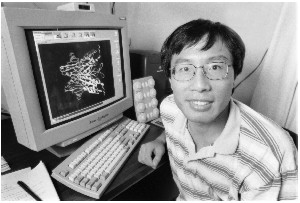
Youngchang Kim, Ph.D., hopes his work will shed light on how hepatitis B contributes to malignancy.
(photo by Anne Rayner)
Researcher on the trail of hepatitis B's knack for cellular shenanigans
The American Cancer Society has awarded a $375,000, three-year grant to support a Vanderbilt University Medical Center biochemist's study of an important protein used by the hepatitis B virus to "hijack" its host's cellular machinery for its own genetic purposes.
Infection by the hepatitis B virus is associated with the development of liver cancer, an often deadly malignancy that will affect an estimated 14,500 people in the United States this year, according to the ACS.
Though his research is not directly involved with the development of liver cancer, Youngchang Kim, Ph.D., said he hopes his work will shed light on a part of the complicated process through which hepatitis B contributes to malignancy.
"My work doesn't look directly at how this protein causes cancer but rather seeks to answer very fundamental questions," said Kim, assistant professor of Biochemistry and a member of the Vanderbilt-Ingram Cancer Center.
"A lot of study needs to be done to know exactly how hepatitis B invades mammalian cells, replicates and causes cancer. The protein that I am studying, called pX, is one of the cancer-causing proteins involved in cancer development. We still don't know exactly how this process occurs. It is very complicated."
The hepatitis B virus spreads through blood, sex or from mother to child at birth. About 200,000 Americans are diagnosed with hepatitis B infection each year. A vaccine to prevent infection became available in 1991.
Specifically, Kim is using a method called X-ray crystallography to learn more about a protein in the hepatitis B virus and how it interacts with a family of proteins inside a mammalian cell. This protein, pX, is known as a transcription factor because it is involved in the process of "reading" the genetic instructions contained in the DNA.
When the hepatitis B virus enters a mammalian cell, the virus uses the cell's DNA transcription machinery to regulate its own genes. However, PX cannot bind directly to the cell's DNA, so it "hijacks" a family of transcription factors in the cell that do recognize and bind to a specific section of DNA.
Kim's research is focused on how that interaction takes place. He uses X-ray crystallography, a computer-assisted technique that produces three-dimensional images of structures at the atomic level, to show exactly how the proteins are interacting with each other.
"By determining the three-dimensional structure of the virus protein and by defining the nature of its interaction with the cellular proteins, Dr. Kim's work could ultimately contribute to the design of drugs that would effectively block that process and thus prevent liver cancer," said Dr. Ralph Vogler, Scientific Director for the ACS' Extramural Grants Program. "Liver cancer is increasing at an alarming rate in the United States, and basic research such as Dr. Kim's is essential for the development of prevention techniques."













